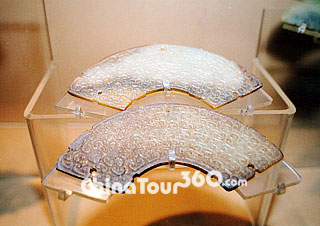 |
| Jade Plates |
In ancient China, Jade was compared with the virtues. Confucius says, 'Virtuous gentle- men are considered as benevolent and observant as jade is smooth and solid'. The charm of jade made with the hand of nature had become a symbol of beauty which has always been pursued in Chinese culture. However, there is a difference between genuine and fake beauty, and jade appreciation has become a subject of wisdom–very deep wisdom. Sometimes it gives the impression of being 100% Category A quality, but in reality is simply B grade. Alternatively, it can appear to be like color-shifting, high-grade emerald yet in reality it has simple been carefully tempered with chromate salts. Fortunately its true nature can be revealed under a filtered light. On other occasions, apparently high quality jade carved with excellent workmanship is found to be worthless 'Japanese Jade'; the tell-tale bubbles in the glass can only be revealed under the microscope.
In the early years of Qing Dynasty (1644 - 1911), the emeralds and jades shipped along the second Silk Road to the west of Yunnan Province were not classified into A or B categories. All of them were considered genuine goods sold at fair trade prices. These jades possessed superior hardness and clarity and even distribution of colors. Such produce included the Laokang glass-types, a lot of high-grade emeralds, such as the Jinsi type, violet types and Baidiqing. They were treated as the most valuable treasures by many jade lovers and wearers. Most emeralds were produced in Myanmar (Burma), which borders China, but the finished products were processed in China. For this reason, it was generally believed in many Western countries that these emeralds were the 'National Jades' of China. The love of jade was the order of the day at the ends of Qing Dynasty and in the early years of the Republic. As indicated in the 'The Book of Changes', anything reaching its peak will inevitable brings something negative: the classification, Category B, only came into being in the 1970s and 80s at the time when the 'Four Little Asian Dragons' experienced their economic ascendancy.
Category B refers to what is known as 'dirty' emeralds, those which are stained or tarnished. They are etched with acid to remove flaws and improve the surface quality, thus enhancing the brilliance and clarity. Epoxy resins or similar substitutes are used to pressure-fill the microscopic cavities left by the etching process. Fake Category A is created this way. Such products appear to be genuine emerald but they lose their brilliance after a couple of years as the flaws re-appear all over the surface. In addition of Category B, there are also Categories C and D. C category relies entirely on the mechanical injection of color for its appearance, but its enhancement will show up as red under filtered light. In addition, the surface color will disappear or turn brown when washed with fading chemicals. Category D simply comprises of those worthless soft jades coming from Japan, Malaysia or Australia. In addition, there are other 'emeralds' that are faked in green glass and plastic, which can further confuse the uninformed purchaser. Though some experts are well equipped with scientific instruments such as spectral analyzers, refractive index meters, specific gravity measures and contact-liquid testers, sometimes they still cannot distinguish the fake from the genuine every time.
According to its Gemologic Definition, its value can exceed that of gold by hundreds if not tens of hundreds of times. That is why the proverb tells: 'There is a price tag for gold but not for jade.' It is however, easy for everyone to appreciate jade in a certain sense: there must be pricelessness, morality, honesty and sincerity behind the most precious piece. The maxim that 'a modest gentleman is mild like a jade object' is a true description. In the words of an authority, 'It is as a matter of fact, not something difficult, to appreciate. All you need is a feeling. Everything has a soul and so does jade. If you are a wise and kind person, if you feel you are connected with it, it is of course, genuine.'







